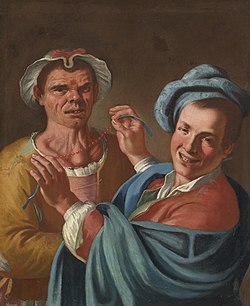
Back Femminielli Catalan Femminiello Spanish Femminielli French Femminiello Galician Femminiello Croatian Femminiello Italian Femmeniello NAP Femminiello Portuguese Фемминиелли Russian Femminiello SIMPLE

| Part of a series on |
| Transgender topics |
|---|
|
|
Femminielli or femmenielli (singular femminiello, also spelled as femmeniello) are a population of people who embody a third gender role in traditional Neapolitan culture.[4][5] It may be hard to define this term within modern Western notions of "gay men" versus "trans women" since both these categories overlap to a degree in the case of femminielli.[5] This term is not derogatory and does not carry a stigma; instead femminielli are traditionally believed to bring good luck.[4][5]
- ^ "The Femminiello." Portland Art Museum. http://portlandartmuseum.us/mwebcgi/mweb.exe?request=record;id=68749;type=101
- ^ "The Femminiello in Neapolitan Culture." Naples: Life, Death, & Miracles. November 2009. Retrieved July 28, 2020. http://www.naplesldm.com/femm.php
- ^ Lang, Nico (11 Jul 2016). "This 18th-Century Italian Painting Proves Gender Nonconformity Is Far From a Modern Invention". Slate. The Slate Group LLC.
- ^ a b Fulvio, Bufi (2009). "Presa Ketty, boss "femminiello" Comandava i pusher di Gomorra". Corriere della Sera (February 13, 2009): 19. Archived from the original on September 14, 2015.
Femminiello è una figura omosessuale (..) è una persona dall' aspetto effeminato o spesso un travestito. È rispettato e generalmente il femminiello viene considerato una persona che porta fortuna.
- ^ a b c Jeff Matthews. "The Femminiello in Neapolitan Culture". Archived from the original on 2011-05-15.
© MMXXIII Rich X Search. We shall prevail. All rights reserved. Rich X Search